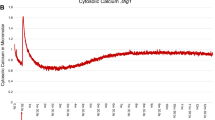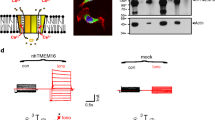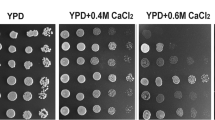Abstract
A human epithelial cell-specific transcript (NB-1) encodes a calmodulin-like protein (hCLP), which is identical in length and 85% identical in amino acid sequence to authentic human calmodulin (hCaM). Although hCaM shares only 60% amino acid sequence identity with yeast calmodulin (CMD1 gene product), hCaM was able to substitute functionally for Cmd1 in yeast cells. In contrast, hCLP was unable to support either spore germination or vegetative growth in Cmd1-deficient yeast cells, even when stably expressed at a level at least an order of magnitude above that of hCaM. Thus, hCLP provides an indicator protein for discerning those residues that are critical for calmodulin function in vivo. In addition to 20 conservative amino acid replacements, hCLP differs from hCaM (and other vertebrate calmodulins that are able to complement acmd1 null mutation) by only three nonconservative substitutions. Site-directed mutagenesis was used to convert these three positions back to residues more typical of those found in authentic calmodulins and to prepare all possible combinations of these three mutations, specifically: three single mutants (R58V, R112N, and A128E), three double mutants (R58V A128E, R112N A128E, and R58V R112N), and the triple mutant (R58V R112N A128E). The triple mutant and one of the double mutants (R58V A128E) were able to restore an apparently normal growth rate to acmd1Δ strain, indicating that the altered hCLPs have acquired the ability to behave as functional calmodulins in yeast. The other two double mutants were able to support growth of Cmd1-deficient cells only weakly, but cells expressing the R112N A128E mutant grew noticeably better than those expressing the R58V R112N mutant. Remarkably, one single mutant (A128E), but not the other two single mutants, was also reproducibly able to support weak growth of acmd1Δ strain. The properties of these gain-of-function, or neomorphic, mutations implicate E128, and to a lesser extent V58, as residues critical for calmodulin action in vivo. Molecular modeling of these positions within the structure of a Ca2+-calmodulin · peptide complex indicates that E128 projects directly into the central cavity occupied by the bound peptide. Thus, E128 may contribute a contact that is vital for the interaction of Cmd1 with one or more of the targets that are essential for yeast cell growth.
Similar content being viewed by others
References
Babu YS, Bugg CE, Cook WJ (1988) Structure of calmodulin refined at 2.2 Å resolution. J Mol Biol 204:191–204
Biggin MD, Gibson TJ, Hong GF (1983) Buffer gradient gels and35S label as an aid to rapid DNA sequence determination. Proc Natl Acad Sci USA 80:3963–3965
Boeke JD; La Croute F, Fink GR (1984) A positive selection for mutants lacking orotidine-5′-phosphate decarboxylase activity in yeast. Mol Gen Genet 197:345–346
Brockerhoff SE, Stevens RC, Davis TN (1994) The unconventional myosin, Myo2p, is a calmodulin target at sites of cell growth inSaccharomyces cerevisiae. J Cell Biol 124:315–323
Chant J (1994) Calmodulin clarified. Curr Biol 4:433–435
Chen EY, Seeburg PH (1985) Supercoil sequencing: a fast and simple method for sequencing plasmid DNA. DNA 4:165–170
Chung CT, Miller RH (1988) A rapid and convenient method for the preparation and storage of competent bacterial cells. Nucleic Acids Res 16:3580
Cohen P, Klee C (1988) Calmodulin. In: Cohen P (ed) Molecular aspects of cellular regulation, vol 5. Elsevier Science, Amsterdam
Craig TA, Watterson DM, Prendergast FG, Haiech J, Roberts DM (1987) Site-specific mutagenesis of the α-helices of calmodulin. J Biol Chem 262:3278–3284
Davis TN (1992a) A temperature-sensitive calmodulin mutant loses viability during mitosis. J Cell Biol 118:607–617
Davis TN (1992b) Mutational analysis of calmodulin inSaccharomyces cerevisiae. Cell Calcium 13:435–444
Davis TN, Thorner J (1989) Vertebrate and yeast calmodulin, despite significant sequence divergence, are functionally interchangeable. Proc Natl Acad Sci USA 86:7909–7913
Davis TN, Urdea MS, Masiarz FR, Thorner J (1986) Isolation of the yeast calmodulin gene: calmodulin is an essential protein. Cell 47:423–431
Edman CF, George SE, Means AR, Schulman H, Yaswen P (1994) Selective activation and inhibition of calmodulin-dependent enzymes by a calmodulin-like protein found in human epithelial cells. Eur J Biochem 226:725–730
Fischer R, Koller M, Flura M, Mathews S, Strehler-Page M-A, Krebs J, Penniston JT, Carafoli E, Strehler EE (1988) Multiple divergent mRNAs code for a single human calmodulin. J Biol Chem 263:17055–17062
Geiser JR, van Tuinen D, Brockerhoff SE, Neff MM, Davis TN (1991) Can calmodulin function without binding calcium? Cell 65:949–959
Geiser JR, Sundberg HA, Chang BH, Muller EG, Davis TN (1993) The essential mitotic target of calmodulin is the 110-kilodalton component of the spindle pole body inSaccharomyces cerevisiae. Mol Cell Biol 13:7913–7924
Harris E (1993) Genetic and physiological analysis of calmodulin function in yeast. PhD thesis, University of California, Berkeley, USA
Harris E, Watterson DM, Thorner J (1994) Functional consequences in yeast of single-residue alterations in a consensus calmodulin. J Cell Sci 107:3235–3249
Hill JE, Myers AM, Koerner TJ, Tzagaloff A (1986) Yeast/E coli shuttle vectors with multiple restriction sites. Yeast 2:163–167
Ikura M, Barbato G, Klee CB, Bax A (1992a) Solution structure of calmodulin and its complex with a myosin light chain kinase fragment. Cell Calcium 13:391–400
Ikura M, Clore GM, Gronenborn AM, Zhu G, Klee CB, Bax A (1992b) Solution structure of a calmodulin-target peptide complex by multidimensional NMR. Science 256:632–638
Ito H, Fukuda Y, Murata K, Kimura A (1983) Transformation of intact yeast cells treated with alkali cations. J Bacteriol 153:163–168
Jennissen HP, Botzet G, Majetschak M, Laub M, Ziegenhagen R, Demiroglou A (1992) Ca2+-dependent ubiquitination of calmodulin in yeast. FEBS Lett 296:51–56
Johnston M, Davis RW (1984) Sequences that regulate the divergentGAL1-GAL10 promoter inSaccharomyces cerevisiae. Mol Cell Biol 4:1440–1448
Koller M, Strehler EE (1988) Characterization of an intronless human calmodulin-like pseudogene. FEBS Lett 239:121–128
Kraulis PJ (1991) MOLSCRIPT: a program to produce detailed and schematic plots of protein structures. J Appl Crystallog 24:946–950
Kretsinger RH (1992) The linker of calmodulin — to helix or not to helix. Cell Calcium 13:363–376
Laemmli UK (1970) Cleavage of structural proteins during the assembly of the head of bacteriophage T4. Nature 227:680–685
Manalan AS, Klee CB (1984) Calmodulin. Adv Cyclic Nucleotide Protein Phosphorylation Res 18:227–279
Meador WE, Means AR, Quiocho FA (1992) Target recognition by calmodulin: 2.4 Å structure of a calmodulin-peptide complex. Science 257:1251–1255
Meador WE, Means AR, Quiocho FA (1993) Modulation of calmodulin plasticity in molecular recognition on the basis of X-ray structures. Science 262:1718–1721
Ohya Y, Anraku Y (1989) Functional expression of chicken calmodulin in yeast. Biochem Biophys Res Commun 158:541–547
Ohya Y, Botstein D (1994) Diverse essential functions revealed by complementing yeast calmodulin mutants. Science 263:963–966
O'Neil KT, DeGrado WF (1990) How calmodulin binds its targets: sequence independent recognition of amphiphilic α-helices. Trends Biochem Sci 15:59–64
Parag HA, Dimitrovsky D, Raboy B, Kulka RG (1993) Selective ubiquitination of calmodulin by UBC4 and a putative ubiquitin-protein ligase (E3) fromSaccharomyces cerevisiae. FEBS Lett 325:242–246
Pausch MH, Kaim D, Kunisawa R, Admon A, Thorner J (1991) Multiple Ca2+/calmodulin-dependent protein kinase genes in a unicellular eukaryote. EMBO J 10:1511–1522
Rao ST, Wu S, Satyshur KA, Ling KY, Kung C, Sundaralingam M (1993) Structure ofParamecium tetraurelia calmodulin at 1.8 A|ucflca| resolution Protein Sci 2:436–447
Rhyner JA, Koller M, Durussel-Gerber I, Cox JA, Strehler EE (1992) Characterization of the human calmodulin-like protein expressed inEscherichia coli. Biochemistry 31:12826–12832
Sambrook J, Fritsch EF, Maniatis T (1989) Molecular cloning: a laboratory manual. Cold Spring Harbor Laboratory, Cold Spring Harbor, New York
SenGupta B, Friedberg F, Detera-Wadleigh SD (1987) Molecular analysis of human and rat calmodulin complementary DNA clones. J Biol Chem 262:16663–16670
Sherman F, Fink GR, Hicks JB (1986) Laboratory course manual for methods in yeast genetics. Cold Spring Harbor Laboratory, Cold Spring Harbor, New York
Sikorski RS, Hieter P (1989) A system of shuttle vectors and yeast host strains designed for efficient manipulation of DNA inSaccharomyces cerevisiae. Genetics 122:19–27
Southern EM (1975) Detection of specific sequences among DNA fragments separated by gel electrophoresis. J Mol Biol 98:503–517
Starovasnik MA, Davis TN, Klevit RE (1993) Similarities and differences between yeast and vertebrate calmodulin: an examination of the calcium-binding and structural properties of calmodulin from the yeastSaccharomyces cerevisiae. Biochemistry 32:3261–3270
Su Z, Fan D, George SE (1994) Role of domain III of calmodulin in activation of calmodulin-stimulated phosphodiesterase and smooth muscle myosin light chain kinase. J Biol Chem, in press
Sun G-H, Ohya Y, Anraku Y (1991) Half-calmodulin is sufficient for cell proliferation. J Biol Chem 266:7008–7015
Sun G-H, Hirata A, Ohya Y, Anraku Y (1992) Mutations in yeast calmodulin cause defects in spindle pole body functions and nuclear integrity. J Cell Biol 119:1625–1639
Török K, Whitaker M (1994) Taking a long, hard look at calmodulin's warm embrace. Bioessays 16:221–224
VanBerkum MFA, Means AR (1991) Three amino acid substitutions in domain I of calmodulin prevent the activation of chicken smooth muscle myosin light chain kinase. J Biol Chem 266:21488–21495
Van Eldik LJ, Wolchok SR (1984) Conditions for reproducible detection of calmodulin and S100b in immunoblots. Biochem Biophys Res Commun 124:752–759
Wawrzynczak EJ, Perham RN (1984) Isolation and nucleotide sequence of a cDNA encoding human calmodulin. Biochem Int 9:177–185
Weinstein H, Mehler EL (1994) Ca2+-binding and structural dynamics in the functions of calmodulin. Annu Rev Physiol 56:213–236
Wright APH, Bruns M, Hartley BS (1989) Extraction and rapid inactivation of proteins fromSaccharomyces cerevisiae by trichloroacetic acid precipitation. Yeast 5:51–53
Yaswen P, Smoll A, Peehl DM, Trask DK, Sager R, Stampfer MR (1990) Down-regulation of a calmodulin-related gene during transformation of mammary epithelial cells. Proc Natl Acad Sci USA 87:7360–7364
Yaswen P, Smoll A, Hosoda J, Parry G, Stampfer MR (1992) Protein product of a human intronless calmodulin-like gene shows tissue-specific expression and reduced abundance in transformed cells. Cell Growth Differ 3:335–345
Author information
Authors and Affiliations
Additional information
Communicated by C. P. Hollenberg
Rights and permissions
About this article
Cite this article
Harris, E., Yaswen, P. & Thorner, J. Gain-of-function mutations in a human calmodulin-like protein identify residues critical for calmodulin action in yeast. Molec. Gen. Genet. 247, 137–147 (1995). https://doi.org/10.1007/BF00705643
Received:
Accepted:
Issue Date:
DOI: https://doi.org/10.1007/BF00705643




